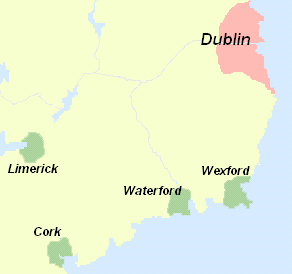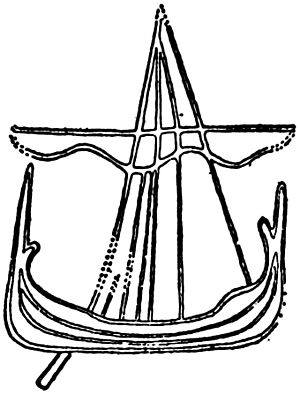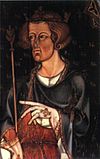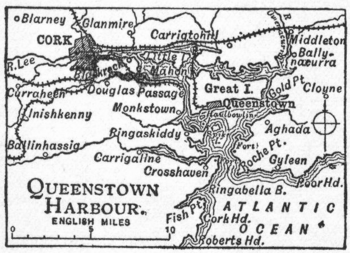Cotter family facts for kids
Quick facts for kids Cotter |
|
|---|---|
| Current region | Throughout Ireland and the Irish diaspora, still numerous in County Cork |
| Earlier spellings | Mac Cotter, Mac Coitir, Mac Oitir |
| Etymology | Son of Óttar |
| Place of origin | Cork city Ireland, of Norse-Gael ancestry |
| Connected families | The Cottier family of the Isle of Man are reputed to be distantly connected. The Coppinger and Skiddy families of Cork are also claimed to have Norse-Gael origins. |
| Distinctions | Baronets of Rockforest |
| Traditions | Claim descent from Óttar of Dublin, a 12th century Norse-Gael king |
| Estate(s) | Coppingerstown Castle Inismore Anngrove (historical) Rockforest |
The Cotter family of Ireland has a long history, especially linked to County Cork and the ancient city of Cork. This family is known as Norse-Gaelic, meaning they have roots from both the Norse (Vikings) and the native Gaelic Irish. In the Irish language, their name is Mac Coitir or Mac Oitir. The family also has connections to the Isle of Man and the Hebrides islands off Scotland.
The name "Cotter" likely comes from Norway. You can find places named after the Cotters in County Cork, like Ballymacotter and Farrancotter. The name is also common on the Isle of Man.
Contents
Norse Roots
The Cotters are one of the few Irish families who can prove they are descended from the Norse Vikings. They managed to survive the Norman invasion of Ireland in the 1100s, unlike many other Norse families. It's not fully known if their Norse connection comes from the father's side or the mother's side.
A family story from later times says the Cotters are descendants of Óttar of Dublin. He was a Norse-Gael king of Dublin from 1142 to 1148. The story says the family came from his son Thorfin and grandson Therulfe. This is possible, but historians haven't fully confirmed it yet. The Gaelic name Mac Coitir originally meant "Son of Óttar", which usually means "descendant of Óttar" in Irish and Scottish traditions.
The Óttar Family Line
Óttar of Dublin belonged to a powerful family often called the "Óttar dynasty." This family included important leaders (called jarls, similar to powerful chiefs or nobles) and sometimes kings in the Irish Sea area. Many members of this family used the name Óttar.
There's a record of a possible family member named Óttar Svarti ("Óttar the Black"). He was from Iceland, which had close ties to Norse settlements in Scotland and Ireland. He wrote a praise-poem for Cnut, who was King of England and Denmark. This shows the connection between Norse leaders and their skill in poetry.
Ottir Iarla
One important Óttar linked to the Munster region in Ireland was Jarl Ottar, also known as Ottir Iarla or Ottir Dub (Óttar the Black). He appears in an old Irish book called Cogad Gáedel re Gallaib. This book says he was involved with the Viking settlement of Cork. After he and another leader, Ragnall ua Ímair, raided several places, they split up, and one group settled in Cork. Ottir also had a significant career in Scotland and England. He is said to have conquered and collected taxes from eastern Munster from his base in Waterford. Ottir likely died in battle around 918.
Historians can't prove that the Cotters of Cork or Mac Ottir of Dublin came directly from this Jarl Ottar. However, he lived at the right time for his name to become a family name. For example, the famous O'Neill dynasty got their name from a leader who lived at the same time, Niall Glúndub.
Ottir Dub
In 1014, a Norse-Gael leader named Ottir Dub (Óttar the Black), who might have been a descendant of Ottir Iarla, fought in the Battle of Clontarf. This battle was between Sigtrygg Silkbeard, the King of Dublin, and Brian Boru, the High King of Ireland. Ottir led a group of Norsemen from Dublin. The old records say that many important leaders, including Ottir Dub, died in this battle. He was considered one of the main leaders and admirals of the Vikings.
Jarl Óttar of Man
The story of Jarl Óttar's rule on the Isle of Man is a bit unclear, but it's known he died there in battle in 1098. One story says that in 1095, King Magnus Barefoot of Norway took control of the Isle of Man and put Óttar in charge. Óttar supposedly made the people in the southern part of the island unhappy, and they rebelled.
Another old book, the Chronicle of Man, says that in 1098, there was a big battle between the Manx people themselves. Óttar and another leader named Macmaras were killed. This civil war made it easy for Magnus Barefoot to take over the island later that year. All stories agree that Óttar's army won the battle, but he was killed along with Macmaras. Jarl Óttar was either the father or grandfather of Óttar of Dublin.
Óttar, King of Dublin
Óttar (in Irish Oitir Mac mic Oitir) came from the Western Isles of Scotland. He took control of the Kingdom of Dublin in 1142. After taking over Dublin, he burned a church in Kells and robbed the town.
Records from the time suggest that Óttar shared power with another king, Ragnall mac Torcaill, until Ragnall was killed in battle around 1145 or 1146. Óttar remained in control of Dublin until 1148, when he was "treacherously killed" by Ragnall's relatives.
Thorfin son of Óttar
Óttar of Dublin's son, Thorfin, was described as a very powerful leader (jarl) in the Hebrides. Thorfin helped replace Godred II Olafsson with Dubgall, the son of Somerled, as the main power in the Hebrides. He traveled through the islands, making many local chiefs accept Dubgall's authority. Some historians believe Thorfin was seeking revenge because Godred might have been involved in Óttar's murder.
Therulfe MacCotter
Therulfe was the son of Thorfin and grandson of Óttar of Dublin. After the Norman Invasion of Ireland, when much of Ireland fell to the Anglo-Normans, Therulfe joined an expedition of 35 ships from Cork in 1173 or 1174. They fought against the Normans in a naval battle. The men from Cork used axes and slingshots, while the Normans used bows and crossbows. The Cork leader was killed, and Therulfe returned to Cork with the remaining ships, where he settled down. He married a woman named Joane or Johanna le Fleming.
While Óttar, Thorfin, and Therulfe are real historical figures, their exact family connections were mainly known from a lost manuscript belonging to the Cotter family of Cork. Some information from this document was later published in a historical journal.
Cotters Outside Ireland
Murdo MacCotter
It seems the Cotter family kept connections outside Ireland. In the 1400s, a man named Murdo MacCotter was in Orkney, fighting under the leader of Clan MacLeod. He is said to have killed the Earl of Orkney in a one-on-one fight. This was probably during a raiding trip from the Hebrides. Murdo MacCotter later became the flag-bearer for the head of Clan Maclean. It's not known if he was from the Cork Cotters or another related family.
Isle of Man
The MacCotters continued to have a presence on the Isle of Man long after the Norse rule ended. There, their family name eventually became "Cottier." This is different from an English surname that looks the same. The Manx MacCotters are believed to be descended from a brother of Óttar of Dublin, who was born on the island.
The Cotters of County Cork
Girod MacCotter
After 1174, many Danes (Norse) left Ireland as they were losing power. Sir Torfin MacCottyr, son of Therulfe, was a brave warrior and a leader of the Danes who stayed. Around 1236, he built a stronghold (a strong castle) in County Cork called Famry Cotter. His son, Sir Girod MacCotter, became a chieftain and gained control of several small towns and areas in Imokilly. Some of these places, like DowneMacCotter and Ballymacotter, still carry his name. A poem was written about him:
'On ye heights of Ballincotter, Gazing on that rugged shore, A Danish chieftan, bold Sir Girod, Thought upon the days of yore, With faded cheeks and rusted armour, Slowly pacing up and down, Ye Lord of Ballincotter mourned His race their loss of royal crowne'. (Author unknown)
Maurice Makotere "from the world's end"
After the Norman invasion, the remaining Norse-Gaelic families, also called 'Ostmen', faced tough times. They didn't have much land outside the cities like the Gaelic Irish did. This forced the Ostmen to work with the new Anglo-Norman rulers. In 1290, a man named Maurice Makotere (Mac Coitir), who was Lord of Famroy Cotter in County Cork, complained to the new authorities. He said that he and 300 of his relatives were being treated like the Irish, but they were "not Irish." He claimed they had paid a huge sum of money (£3000) to get the same rights as Englishmen. Edward I of England then declared that Maurice Makotere was "a pure Englishman," like his ancestors, and deserved his rights. This was a legal way to protect them, even though they weren't actually English.
Maurice Makotere wrote his complaint from a place he called "the world's end." There is a place in Kinsale, Cork, with that name, which historically had the same meaning in Irish.
Over time, even the Anglo-Norman families in Ireland became very Irish in their culture. The Mac Cotters also went through this process. Later, many Cotters became famous poets and writers in the Irish language, and their leaders were among the last to support Gaelic literature.
Two Branches
From the late 1400s, there were two main branches of the Cotter family in County Cork. One was based at Coppingerstown Castle, and the other at Inismore (Great Island, where the port of Cobh is now). The family name was usually "MacCotter" until the 1600s, when "Cotter" became more common. However, in Irish language writings, the name remained Mac Coitir. Many place names in East Cork, like Ballymacotters, show the Cotter family's long presence. Like some other Irish families, branches of the Cotter family were sometimes known by colors. The Inismore Cotters were the 'Yellow Cotters' (Mac Coitir Buidhe), and others (possibly from Coppingerstown) were the 'Red Cotters' (Mac Coitir Ruadh).
The Cotters of Coppingerstown
In 1585, John Cotter of Coppingerstown, who owned 174 acres of land, gave it to his son. He asked his son to share it with his cousins, following their family traditions. The Coppingerstown Cotters, thought to be the older branch, were connected by marriage to the de Barry family. During the Commonwealth period in the mid-1600s, William, the head of the Coppingerstown Cotters, lost his lands. This happened because he took part in the Irish Rebellion of 1641 on the side of the Catholic Irish. He is listed among those who lost their property under the Cromwellian Settlement.
The Cotters of Inismore and Anngrove
The history of this branch is better documented. The earliest known member was William Cottyr, who lived during the time of King Edward IV (1461–1483). His direct descendant was Edmond Fitz Garret Cotter. Edmond owned a lot of land in Inismore and at Ballinsperrig (later called Anngrove), where he lived. The Cotter family seems to have owned large parts of Inismore Island since at least 1572. Unlike the Coppingerstown Cotters, Edmond Cotter of Anngrove's family survived the difficult times from 1641, including the conquest by Oliver Cromwell. They even became more prosperous and gained more land. Edmond Cotter married twice and had many children. This might have meant less inheritance for his second son, James Fitz Edmond Cotter, who became a very important member of the Cotter family in the early modern period.
Sir James Fitz Edmond Cotter
Born around 1630, James Cotter supported the Royalist side during the English Civil War. When Charles II became king again in 1660, James was a lieutenant in an infantry regiment. James Cotter became famous by helping to arrange the killing of John Lisle, who was involved in the trial and execution of King Charles I. This happened in Switzerland in 1664. In 1666, James went to the West Indies. In 1667, he led 700 men in an attack on St Christopher's island but was captured by the French. In 1681, he was made Governor of the island of Montserrat. With money from the king and his earnings as governor, James Cotter became very rich. He was likely close to King James II and may have served with him at sea. James Cotter is believed to have been knighted by King James in 1685.
King James II became a Roman Catholic. When he had a son who would also be raised Catholic, it led to the Glorious Revolution of 1688, and James fled England. To try and get his throne back, King James landed in Ireland in March 1689 with French soldiers. At this time, Sir James Cotter, who was Catholic like his king, was made commander of the Jacobite forces in Cork. In 1691, Cotter became a Brigadier General, in charge of all Jacobite forces in counties Cork, Kerry, Limerick, and Tipperary. During his time in charge, Sir James Cotter treated the Protestant landowners well. Because of his fair treatment, when the Jacobite forces surrendered under the Treaty of Limerick, his Protestant neighbors supported him, allowing him to keep all his property and lands.
Sir James Cotter was a great supporter of Irish language poetry and writings, much like earlier Irish chieftains. He died in 1705. His oldest son, James, inherited his wealth and his role as a leader for the Catholic people of Cork. However, his son was not as politically smart and sadly ended his life by execution.
James Cotter the Younger
James Cotter the Younger (Séamus Óg Mac Coitir) was the victim of a famous case of unfair trial and execution in Cork City in 1720. He was the older son of Sir James Fitz Edmond Cotter. Like his father, he openly supported the Jacobite cause (supporting King James II and his family). He was seen as the natural leader of the Catholic community in Cork City and County Cork. News of his execution caused widespread riots across Ireland. His death also became the subject of many poems in Irish.
Cotter Baronets, of Rockforest (1763)
The Cotter Baronetcy of Rockforest in County Cork was created on August 11, 1763. A Baronetcy is a special title that can be passed down through the family, similar to a knight but hereditary. The first Baronet was James Cotter, who was a member of the Irish House of Commons. He was the son of the executed James Cotter the Younger. The authorities made sure that the first baronet and his siblings were raised as Protestants. This action removed one of the families who had traditionally led the Catholic community in Ireland. In the end, the descendants of Sir James Fitz Edmond Cotter kept their wealth and political importance, but they lost the Catholic faith and culture that their ancestors had strongly supported for a long time.
The current title holder is Sir Julius Cotter, the 8th Baronet. He became the Baronet after his father, Sir Patrick Cotter, the 7th Baronet, passed away on January 11, 2023.
See also





